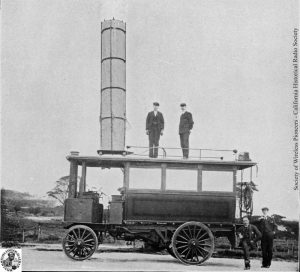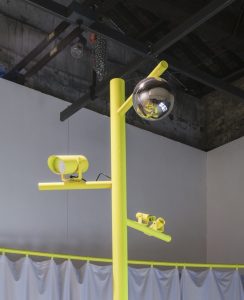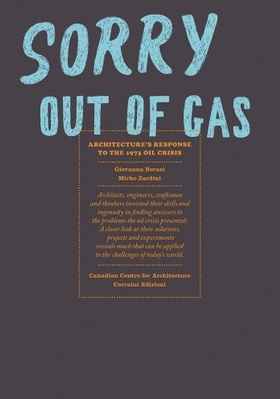 Sorry, Out of Gas: Architecture’s Response to the 1973 Oil Crisis, by Mirko Zardini and Giovanna Borasi. With essays by Adam Bobbette, Daria Der Kaloustian, Pierre-Édouard Latouche, Caroline Maniaque, Harriet Russell (Amazon USA and UK.)
Sorry, Out of Gas: Architecture’s Response to the 1973 Oil Crisis, by Mirko Zardini and Giovanna Borasi. With essays by Adam Bobbette, Daria Der Kaloustian, Pierre-Édouard Latouche, Caroline Maniaque, Harriet Russell (Amazon USA and UK.)
Publishers Edizioni Corraini and Canadian Centre for Architecture describe the book as follows:From November 7th, 2007 to April 20th, 2008 the Canadian Centre for Architecture in Montreal hosts the exhibition “1973: Sorry, Out of Gas”, curated by CCA Director Mirko Zardini and Giovanna Borasi. The exhibition examines the oil crisis of 1973 as a major precedent of contemporary concerns about energy resources and fossil fuel dependency. In fact, the 1973 shortage triggered research and development of renewable energy sources, improved technologies, and social experiments that were to have an enduring impact on the architectural and political fields both in America and Europe. The catalogue of the exhibition is co-published by the Canadian Centre for Architecture and Corraini Edizioni. Book design by Massimo Pitis.
An illustrated tale by Harriet Russell, specially conceived on this occasion, introduces the book from a child’s point of view. Her amusing drawings create ironic and funny situations in order to make children familiar with energy saving and oil dependency concerns.
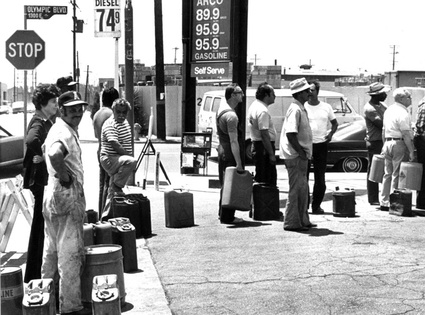 Line-up at a Los Angeles gas station in anticipation of rationing, 11 May, 1979, Photograph © KPA
Line-up at a Los Angeles gas station in anticipation of rationing, 11 May, 1979, Photograph © KPA
I would have miss this brilliant and superbly documented book had i not received it as a present from the lovely people at For your Art during the Postopolis blogathon in Los Angeles last April.
Sorry, Out of Gas is the catalog of an exhibition of the same title that ended in April 2008 at the Canadian Centre for Architecture in Montreal. I wish i’ll get to visit CCA one day as they seem to regularly set up truly innovative exhibitions.
Sorry, Out of Gas explored the architectural innovation spurred by the 1973 oil crisis, when Middle East producers declared a boycott and the value of oil increased exponentially and triggered economic, political, and social upheaval across the world.
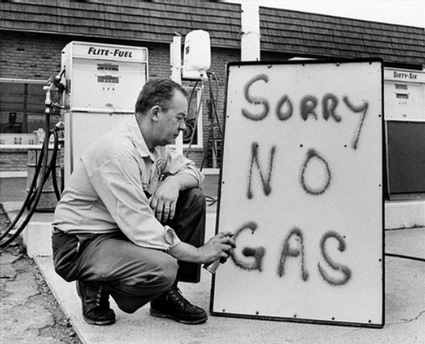 June 1, 1973, Leon Mill spray paints a sign outside his Phillips 66 station in Perkasie, Pa. to let his customers know he is out of gas (image)
June 1, 1973, Leon Mill spray paints a sign outside his Phillips 66 station in Perkasie, Pa. to let his customers know he is out of gas (image)
Thirty years ago already, industrialized economies realized they might be relying too heavily on crude oil. Researchers, inventors, engineers, activist groups and architects came up with innovations and experiments aimed at preserving, renewing or creating new forms of energy. Today, it seems that much of their work (at the notable exception of Buckminster Fuller) and ideas have sunk into oblivion.
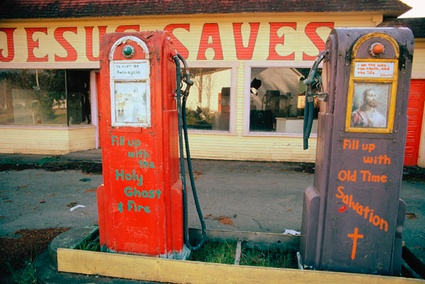 Gas stations abandoned during the fuel crisis were sometimes used for other purposes. This station at Potlatch, Washington, was turned into a religious meeting hall Photo by David Falconer, April 1974
Gas stations abandoned during the fuel crisis were sometimes used for other purposes. This station at Potlatch, Washington, was turned into a religious meeting hall Photo by David Falconer, April 1974
The book and exhibition attempt to remind us that the architects, designers and other ‘luminaries’ who are currently brandishing the magic word sustainability might want to acknowledge the pioneering work carried out more than 3 decades ago. As CCA Director and exhibition curator Mirko Zardini explained, “By providing insight on the forerunners of many contemporary approaches to sustainable living, the exhibition aims to increase public awareness and encourage contemporary research in the field.”
The book starts with “An Endangered Species”, a lovely illustrated tale that explains to children our dependence on oil, the existence of alternative sources of energy and the little steps families can take to cut back on consumption.
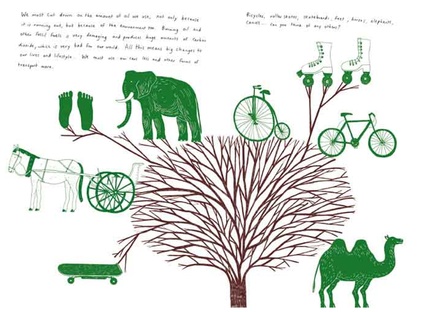 Illustration by Harriet Russell (image)
Illustration by Harriet Russell (image)
Then comes an essay by Mirko Zardini and a chapter dedicated to oil, from the embargo to the games that were created at the time to educate or even sometimes dedramatize the issue. I was particularly fascinated by a series of discourses pronounced in the 70s by world leaders. They were much bolder and more undisguised than the ones voiced by today’s politicians. It feels like our leaders prefer to tread much more carefully and are afraid of causing us any discomfort.
The rest of the book is divided in chapters that correspond to alternative sources of energy and their use in architecture: Sun, Earth, Wind and Integrated Systems.
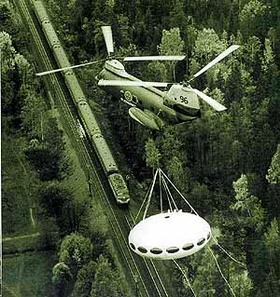 The houses constructed at the time were far less pretty than the ones that are built today with the same attention for saving and generating energy. Not that the times could not do stylish. Matti Suuronen had just created Futuro House after all. It was the first plastic house designed to be delivered in one piece anywhere the world by helicopter. As alluring as it might be, the project failed. Partly because of the swelling of oil prices and the consequent tripling of the cost of plastics.
The houses constructed at the time were far less pretty than the ones that are built today with the same attention for saving and generating energy. Not that the times could not do stylish. Matti Suuronen had just created Futuro House after all. It was the first plastic house designed to be delivered in one piece anywhere the world by helicopter. As alluring as it might be, the project failed. Partly because of the swelling of oil prices and the consequent tripling of the cost of plastics.
Times called for a new austerity, for a more sensible and DIY aesthetics. A few examples worth mentioning:
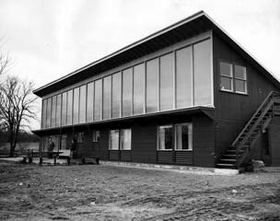 Image: Wide World Photo, the MIT News Office, and the MIT Museum
Image: Wide World Photo, the MIT News Office, and the MIT Museum
The Dover Sun House was the first solar home that was actually inhabited. Entirely heated by solar energy, it had been deliberately designed without back-up heating system. It was made by three women: sculptor Amelia Peabody commissioned its construction, Dr. Maria Telkes, an assistant in MIT’s Department of Metallurgy, designed the house heating unit and architect Eleanor Raymond drew up the plans and supervised the construction.
John Barnard’s Ecology House is the outcome of the architect asking himself the question “How to make a house that resembles a park?” The answer came into the form of a construction sunk underground, with 25 to 40 cm of soil on the roof. Rooms receive natural light through the central open-air atrium shown below:
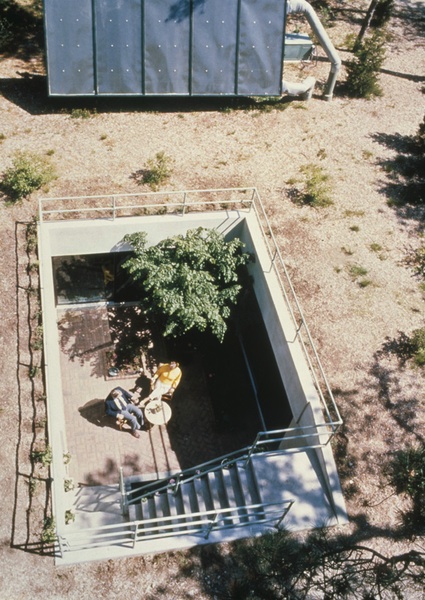 John E. Barnard Jr., architect. Ecology House, Osterville, Massachusetts, 1973. View into courtyard with solar panel
John E. Barnard Jr., architect. Ecology House, Osterville, Massachusetts, 1973. View into courtyard with solar panel
In 1976, a tenant-owner cooperative installed on the roof of their building at 519 East 11th Street in Manhattan solar collectors and a wind generator with the aim of using the energy for the public space inside the building. The system was connected to the Con Edison network, the company that had the monopoly for supplying power in the area. The energy generated was used in parallel with the supply from Con Ed. Over the first 5 months, the system met 110% of the overall demand.
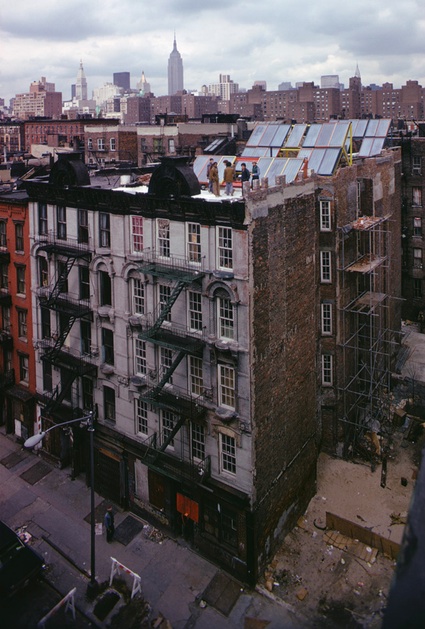 Solar collectors installed on rooftop at 519 East 11th Street, NYC, ca. 1976, Photograph © Jon Naar, 1976/ 2007
Solar collectors installed on rooftop at 519 East 11th Street, NYC, ca. 1976, Photograph © Jon Naar, 1976/ 2007
Images from inside the book:
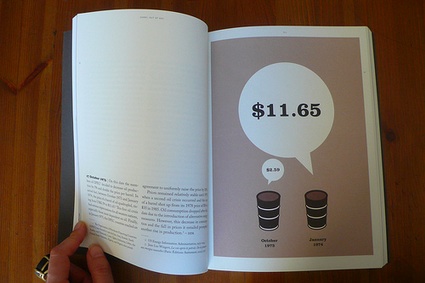
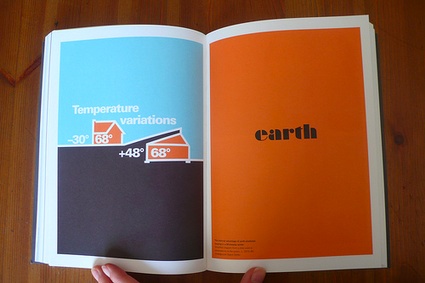
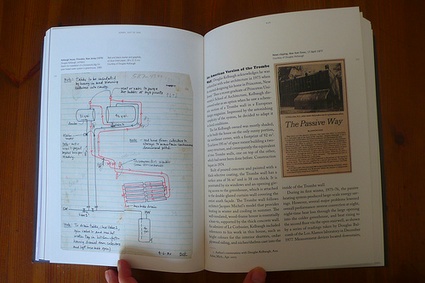
More photos from the exhibition on arttattler and designboom. Image on the homepage from Washington Post.
Related stories: Radical Nature – Art and Architecture for a Changing Planet 1969-2009, The Golden Institute for Energy (follow-up coming soon), Ecological Strategies in Today’s Art (part 1).



